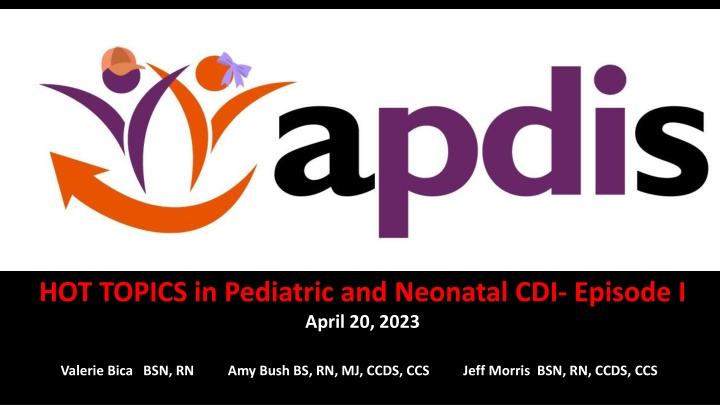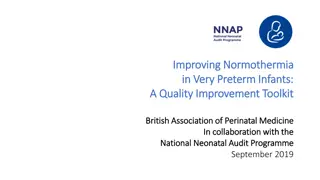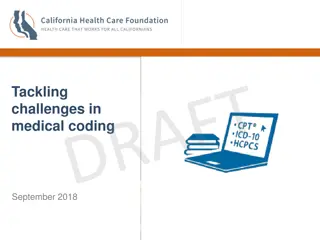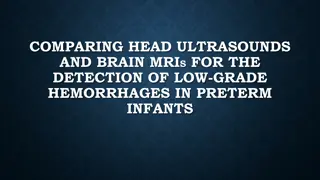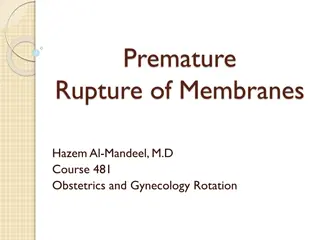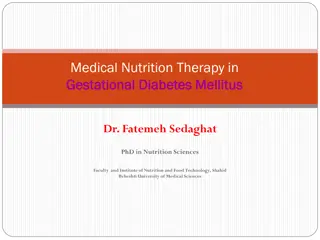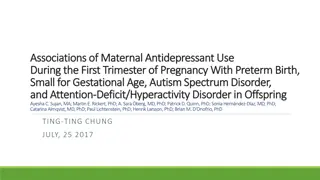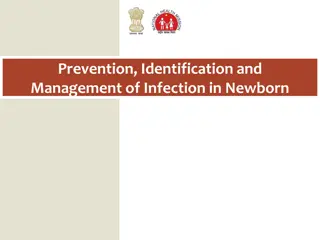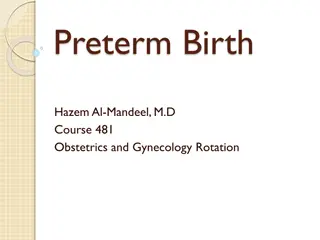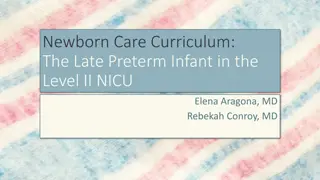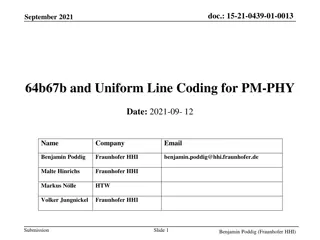The Coding Guidelines for Preterm Newborns with Small for Gestational Age (SGA)
Explore the guidelines for coding preterm newborns who are small for gestational age, including birth weight considerations and criteria for assigning appropriate ICD-10 codes. Gain insights into differentiating SGA from low birth weight and effectively documenting neonatal cases.
Download Presentation

Please find below an Image/Link to download the presentation.
The content on the website is provided AS IS for your information and personal use only. It may not be sold, licensed, or shared on other websites without obtaining consent from the author.If you encounter any issues during the download, it is possible that the publisher has removed the file from their server.
You are allowed to download the files provided on this website for personal or commercial use, subject to the condition that they are used lawfully. All files are the property of their respective owners.
The content on the website is provided AS IS for your information and personal use only. It may not be sold, licensed, or shared on other websites without obtaining consent from the author.
E N D
Presentation Transcript
HOT TOPICS in Pediatric and Neonatal CDI- Episode I April 20, 2023 Valerie Bica BSN, RN Amy Bush BS, RN, MJ, CCDS, CCS Jeff Morris BSN, RN, CCDS, CCS
Todays Speaker for Hot Topics: Amy Bush, BS, RN, MJ, CCDS, CCS Clinical Documentation Improvement Specialist III Cooper University Health Care
Introducing Our Hot Topics: SGA: No small matter Newborn Resuscitation- What is normal Special Delivery- Capturing NICU involvement in the delivery room Late metabolic acidosis of the neonate- How late is late? Disclaimer: This is a forum for discussion and not meant to replace or challenge any official Guideline or Coding Clinic advice. Please be mindful that our clinical backgrounds, experience, and CDI programs are different and strive to share your knowledge as well as benefit from others as well.
SGA: No Small Matter SGA: No Small Matter Original Question: HOW DO YOU CODE PRETERM NEWBORNS THAT ARE SGA OR LIGHT FOR DATES? Clinical Situation: Preterm- 26 week gestational age infant, provider documents 320 grams birth weight, severe SGA From the ICD-10-CM Official Guidelines 2023, Page 71-72: (same for 2018-2023) d. Prematurity and Fetal Growth Retardation Providers utilize different criteria in determining prematurity. A code for prematurity should not be assigned unless it is documented. Assignment of codes in categories P05, Disorders of newborn related to slow fetal growth and fetal malnutrition, and P07, Disorders of newborn related to short gestation and low birth weight, not elsewhere classified, should be based on the recorded birth weight and estimated gestational age. When both birth weight and gestational age are available, two codes from category P07 should be assigned, with the code for birth weight sequenced before the code for gestational age.
Original Question: HOW DO YOU CODE PRETERM NEWBORNS THAT ARE SGA OR LIGHT FOR DATES? Clinical Situation: Preterm- 26 week gestational age infant, provider documents 320 grams birth weight, severe SGA So other than in a term infant, when do you use the P05 code to indication small for gestational age? Let s look at some references: Clinical: Vaccine. 2017 Dec 4; 35(48Part A): 6518-6528 "A related term is low birth weight (LBW), defined as a birth weight of less than 2500 g, regardless of gestational age at the time of birth. Additional related terms include very low birth weight (VLBW) which refers to less than 1500 g, and extremely low birth weight (ELBW) which is less than 1000 g. Normal weight at term delivery is 2500 4200 g. LBW is discussed further in a separate document for this definition. It is important to be clear that SGA is not a synonym of LBW, VLBW or ELBW. Approximately one third of LBW babies weighing less than 2500 g are also SGA 2016 4Q, PP 55-56 Low birth weight is defined as a birth weight of a liveborn infant of less than 2500 grams, regardless of gestational age. Small for gestational age (SGA) or light-for-dates newborns are those who are smaller in size than normal for the gestational age, most commonly defined as weight below the 10th (or 5th) percentile for the gestational age. Although this cutoff is approximately 2500 grams for a full-term infant, it may be higher, depending on the underlying birth weight distribution. Although the great majority of preterm births (liveborn infant less than 37 weeks of gestation) are associated with low birth weight, at least 10% of newborns in their 37th week of gestation exceed 2,500 grams. - Courtesy of Dana Howard
Original Question: HOW DO YOU CODE PRETERM NEWBORNS THAT ARE SGA OR LIGHT FOR DATES? Clinical Situation: Preterm- 26 week gestational age infant, provider documents 320 grams birth weight, severe SGA So other than in a term infant, when do you use the P05 code to indication small for gestational age? Let s look at some historical references: 2016, October 1 Effective Coding Revision the Excludes note was moved from beneath category P07 to beneath subcategory P07.0 and P07.1 (Extremely and Other low birthweight infants) 2017, October 1 Update to official coding guideline DELETED Codes from category P05 should not be assigned with codes from category P07 This would seem to indicate that you use one code for birthweight: (P05-, P07.0, P07.1) and one code for gestation (P07.3) - Courtesy of Dana Howard
Original Question: HOW DO YOU CODE PRETERM NEWBORNS THAT ARE SGA OR LIGHT FOR DATES? Clinical Situation: Preterm- 26 week gestational age infant, provider documents 320 grams birth weight, severe SGA Recent Coding Clinic Response: in response to your request for clarification regarding code assignment for prematurity and small for gestational age (SGA) of a newborn. Codes from category P05, Disorders of newborn related to slow fetal growth and fetal malnutrition, should not be assigned with codes from subcategories P07.0, Extremely low birth weight newborn, and P07.1, Other low birth weight newborn, as instructed by the Excludes1 note. When both birth weight and gestational age are available, as in the case submitted, two codes from category P07 should be assigned, with the code for the birth weight (P07.0- or P07.1-) sequenced before the code for the gestational age (P07.2- or P07.3-). Codes from category P07 should not be assigned unless the provider specifically documents that the newborn is premature. Codes in category P05 do not imply prematurity, but indicate that the newborn is lighter/smaller than expected for the length of gestation. - Contributed by Amy Bush
Original Question: HOW DO YOU CODE PRETERM NEWBORNS THAT ARE SGA OR LIGHT FOR DATES?
NEWBORN RESUSCITATION: WHAT IS NEWBORN RESUSCITATION: WHAT IS NORMAL? NORMAL? Original Question: What/when do you code for newborn resuscitation after birth? Clinical Situation: Current institutional guideline states, can only pick up CPAP if >5 minutes. Discussion Points: PPV and CPAP are not required on all deliveries, not the normal perfect transition per NICU champion but could possibly be included in normal transition- query Will query for respiratory diagnosis and purpose of interventions- if delayed transition, then will not code respiratory diagnoses, but will code the interventions - Courtesy of Donna Laurin Agree but would not query with respiratory insufficiency as it is a high risk denial - Courtesy of Catherine Lloyd
Original Question: What/when do you code for newborn resuscitation after birth? Clinical Situation: Current institutional guideline states, can only pick up CPAP if >5 minutes. Coding Clinics: 2Q 2008 The use of supplemental oxygen and bag ventilation is an integral part of the care of a newborn. Do not assign additional codes for the brief use of bag/mask ventilation and oxygen. Some newborns may experience difficulty transitioning to extrauterine life and may require a period of supplemental oxygen, and spontaneous respirations can often be stimulated using a manual resuscitation bag and face mask (BMV). In most cases, infants respond to these measures with no further interventions. In cases where they do not respond and mechanical ventilation is required, the mechanical ventilation codes should be used. 1Q 2017 Do not assign a code for the brief use of PPV that is done for resuscitation, as it is considered inherent to the delivery. NIV is not mechanical ventilation. If a newborn receives ongoing ventilatory assistance using NIV, it should be coded. However, if NIV is briefly administered to the newborn for the purpose of resuscitation, it is not coded. - Courtesy of Amy Langone Neonatal Resuscitation Program- AAP The NRP actually states in one of their test questions that providing CPAP/PPV is indicative of respiratory failure (they specifically say respiratory failure) after delivery Coding Clinic is pending to clarify the older coding clinics. - Courtesy of Dana Howard
Original Question: What/when do you code for newborn resuscitation after birth? Clinical Situation: Current institutional guideline states, can only pick up CPAP if >5 minutes. Some Clinical Considerations: According to NRP normal transition= warming, stimulation, bulb suctioning Cord ABG/VBG: If cord ABG is significantly more acidotic than the VBG that would be indicative of acute fetal distress or if both are acidotic could be an indication of chronic fetal distress/hypoxia. Consider if the infant did not receive the total 60 seconds of delayed cord clamping and the reason Look for documentation of decelerations or other signs of fetal distress/hypoxia, NICU documentation of non- reassuring fetal status It can be difficult getting clarity through queries on these cases when multiple providers are involved in the infant s care - Courtesy of Dana Howard Other responses represented institutional-specific practices and personal experiences. We do not currently have a universal definition upon which to base practice (as with many pediatric conditions). It does appear that denials based on this issue seem to not occur, at least from the responders.
Some More Clinical Considerations: Is this the point at which normal resuscitation ends? Clinically, perhaps, but we still have to use the coding Guidelines and Coding Clinic guidance to determine how to code the clinical situation. - NALS criteria Courtesy of Cara Parker Other responses represented institutional-specific practices and personal experiences. We do not currently have a universal definition for CDI upon which to base practice (as with many pediatric conditions). It does appear that denials based on this issue are not common per the respondees.
Original Question: Special Delivery: Capturing NICU involvement in the delivery room Clinical Situation: NICU called to delivery for and the delivery ends up being normal. Coding guidelines say we can add for conditions that require clinical evaluation, increased nursing care/monitoring, or require resource utilization. I think this question has probably been answered through the process of analyzing normal resuscitation. Does anyone have anything to add to this? - Courtesy of Candace Dowhaniuk
Late Metabolic Acidosis of the Newborn: Late Metabolic Acidosis of the Newborn: How late is late? How late is late? Original Question: What is the criteria to determine if a neonate has late metabolic acidosis (P74.0) vs. Newborn acidosis (P84.0) Some information from Up-To-Date and an institutional resource: Late Metabolic Acidosis- Occurs 2-3 weeks of age, healthy LBW infant who fails to grow and has a base deficit in excess of 5 mEq/l (CO2 Total less than 21mm). Typically have elevated kidney acid, may be asymptomatic. Causes include pyloric stenosis, metabolic disorder, dehydration, diarrhea, sepsis. Confirmed via blood gas analysis. Metabolic Acidosis- Occurs within 24-48 hours of birth, common symptoms are ketoacidosis, hypotonia, dehydration, lethargy, loss of appetite, unusual odor. Decreased pH, normal Co2, decreased HCO3. - Courtesy of Catherine Lloyd Coding Clinic Response Received: 2020: Category P19, Metabolic acidemia in newborn was indexed as follows: Acidemia - metabolic (newborn) P19.9 -- first noted before onset of labor P19.0 -- first noted during labor P19.1 -- noted at birth P19.2 The excludes 1 note at P74.0, Late metabolic acidosis of newborn, references category P19, for metabolic acidosis of newborn. - Courtesy of Deb Clark
Late Metabolic Acidosis of the Newborn: Late Metabolic Acidosis of the Newborn: How late is late? How late is late? Original Question: What is the criteria to determine if a neonate has late metabolic acidosis (P74.0) vs. Newborn acidosis (P84.0) Some information from a NICU Clinical Medical Director: Agrees the scholarly literature on this issue is very dates, which was my conclusion (end of 1970s). In practice, any infant more than a few weeks off TPN generally does not have significant acidosis. If they do, there is generally some underlying issue (metabolic, endocrine, renal). Often will add metabolic acidosis to the problem list, not from the perspective of coding, but so clinically everyone is on the same page. - Contributed by Amy Bush Has anyone written to Coding Clinic on this topic?
Late Metabolic Acidosis of the Newborn: Late Metabolic Acidosis of the Newborn: How late is late? How late is late? - Contributed by Catherine Lloyd
OUR NEXT QUARTERLY MEETINGS June 1st, 2023 September 7th, 2023 December 7th, 2023 Sharing Knowledge is ESSENTIAL! Let Us Know If You Or Someone You Know Can Present! Sharing Knowledge is ESSENTIAL! Let Us Know If You Or Someone You Know Can Present!
